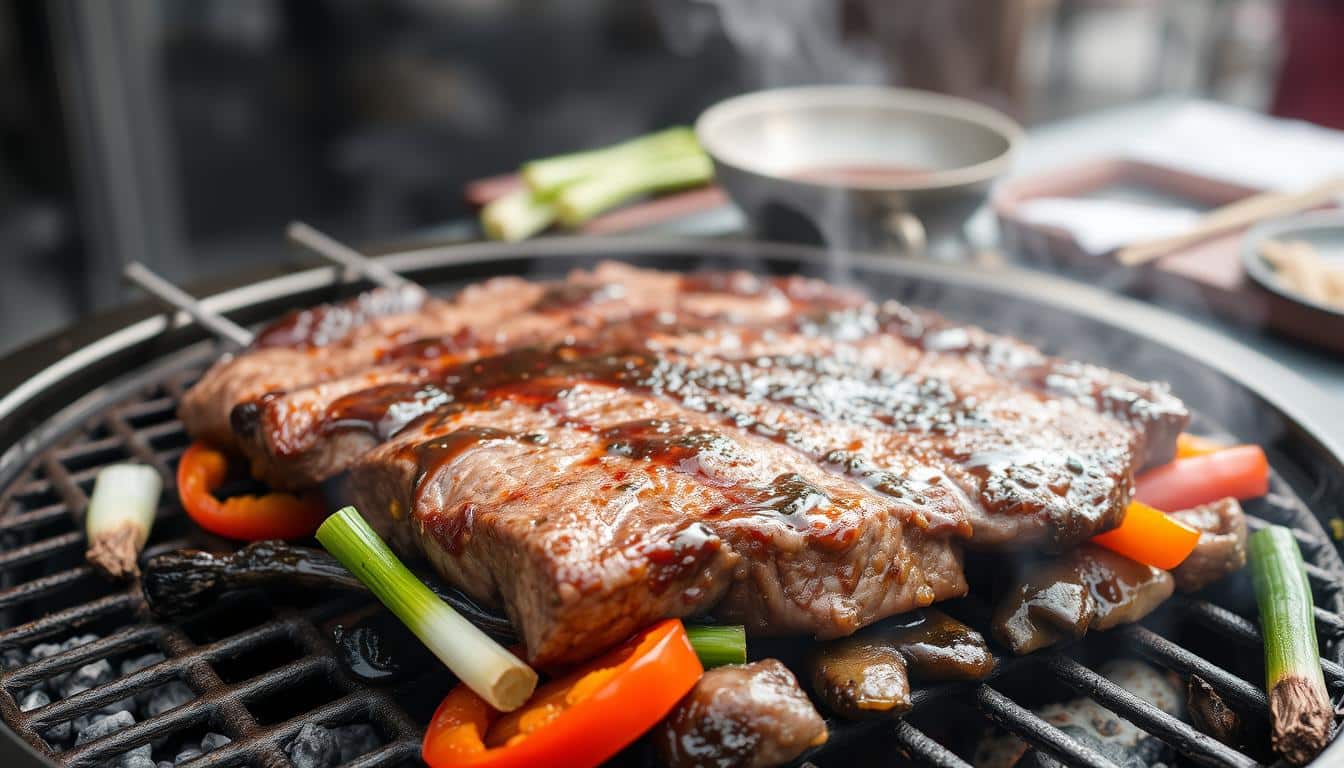Korean Bulgogi-Style Steak is a favorite dish that’s becoming very popular. It’s a marinated beef dish that’s key to Korean BBQ. It’s known for its deep flavors and soft texture. We’re excited to share this real recipe with you, so you can taste Korea at home.
We’ll show you how to make this classic Asian BBQ dish. You’ll learn how to pick the best beef and how to marinate it. You’ll discover the secrets to making this delicious meal. Get ready to wow your family and friends with your new Korean cooking skills!
The Rich History of Korean BBQ and Bulgogi
Korean BBQ is a big part of our food history. Bulgogi is at its center. This tasty dish has won over many hearts over the years. It started in royal feasts and now is loved on the streets.
Origins of Bulgogi in Korean Cuisine
Bulgogi comes from the Goguryeo era, from 37 BC to 668 AD. It was first called ‘maekjeok,’ a dish for nobles. Now, it’s thinly sliced, marinated beef.
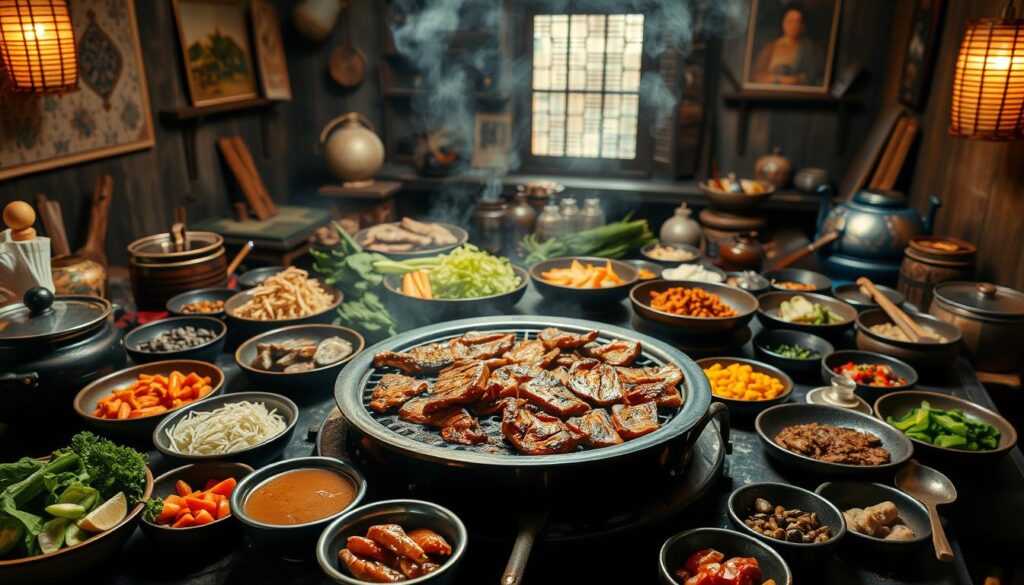
Evolution from Royal Courts to Modern Tables
As Korea changed, bulgogi sauce recipes spread. It became a dish for celebrations, bringing families together. Today, Korean flavors like bulgogi are loved all over, with many new recipes.
Cultural Significance in Korean Dining
Korean BBQ is more than food; it’s a time to come together. People gather around the grill, sharing meat and stories. This shows Korean values of togetherness and welcoming others.
“Bulgogi isn’t just a meal, it’s a celebration of our heritage and the joy of sharing good food with loved ones.”
Bulgogi’s story is like Korea’s own. It started simple and became famous worldwide. Every bite is a taste of history and innovation.
Essential Ingredients for Korean Bulgogi-Style Steak
Making real Korean bulgogi needs the right ingredients. We’ll show you how to pick the best beef, marinade, and seasonings. These will make your dish taste like true Korean flavors.
Selecting the Perfect Cut of Beef
Choose well-marbled cuts like ribeye or sirloin for tender bulgogi. These cuts soak up marinades well, making the meat juicy. Slice the beef thinly against the grain for the best tenderness.
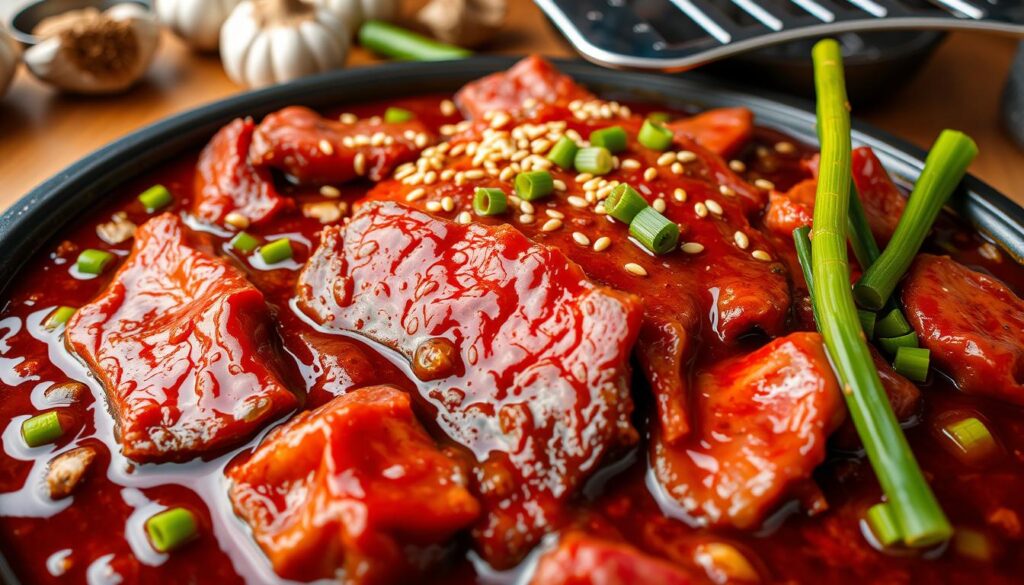
Traditional Marinade Components
The marinade is bulgogi’s heart. It includes:
- Soy sauce: Adds saltiness and umami
- Asian pear: Makes the meat tender
- Garlic and ginger: Give a deep aroma
- Brown sugar: Balances flavors and helps caramelize
- Sesame oil: Adds a nutty taste
Authentic Asian Seasonings and Substitutes
To get true Korean tastes, use these seasonings:
- Gochugaru (Korean red pepper flakes): Adds a bit of heat
- Doenjang (fermented soybean paste): Boosts umami
- Rice wine: Tenderizes and adds sweetness
Can’t find these? Use sriracha, miso paste, and dry sherry instead. They won’t be the same, but they’ll add tasty Asian flavors to your dish.
Mastering the Bulgogi Marinade
Making the perfect bulgogi sauce is key to authentic Korean flavors. We’ll show you how to make a tasty marinade for steak. It captures the essence of Korean cuisine.
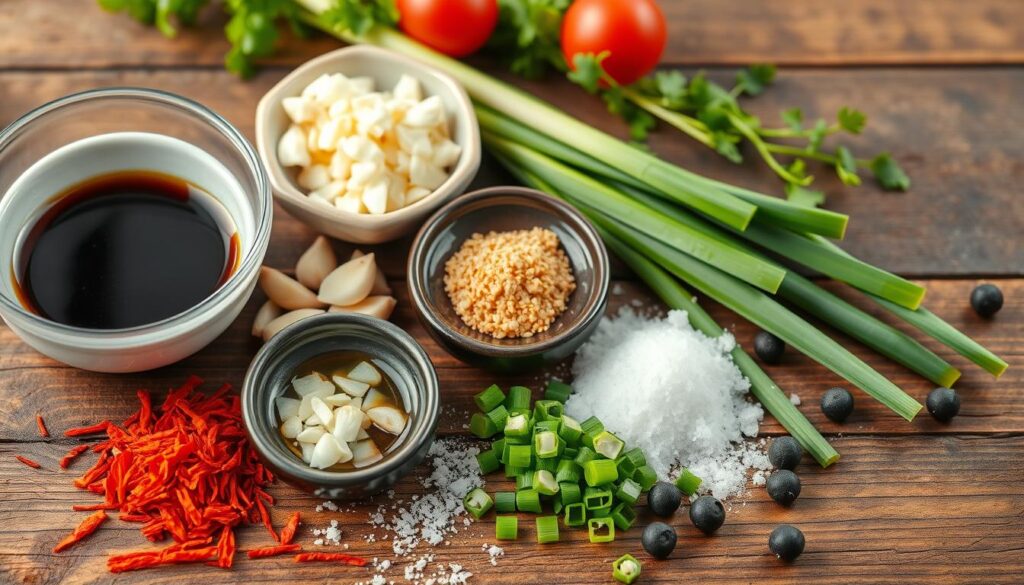
Start with soy sauce as your base. This umami-rich ingredient is the foundation of our bulgogi sauce. Add brown sugar and honey for sweetness, balancing the savory elements. Grated Asian pear adds a subtle fruity note and tenderizes the meat.
For depth, add minced garlic and ginger. These aromatic ingredients are key in Korean recipes. They make the marinade more complex. A splash of sesame oil adds nuttiness and rounds out the flavors.
- Soy sauce: 1/2 cup
- Brown sugar: 1/4 cup
- Honey: 2 tablespoons
- Asian pear: 1/4 cup, grated
- Garlic: 4 cloves, minced
- Ginger: 1 tablespoon, minced
- Sesame oil: 2 tablespoons
Combine all ingredients in a bowl, whisking until the sugar dissolves. This marinade is great on thinly sliced beef. It infuses it with Korean flavors. For best results, marinate the meat for at least 30 minutes before grilling.
“The secret to great bulgogi lies in the perfect balance of sweet and savory in the marinade.”
Try different proportions to find your favorite. Some like it sweeter, others more savory. The beauty of homemade marinades is you can customize while staying true to authentic recipes.
Proper Meat Preparation Techniques
Preparing Korean Bulgogi-Style Steak needs careful attention. We’ll look at key steps to make your beef recipes better. This will help you create perfectly marinated beef.
Slicing Methods for Tender Results
To get tender Korean Bulgogi-Style Steak, slice the beef against the grain. Try for slices that are about 1/8 inch thick. This makes the meat cook fast and stay tender.
Freezing the beef for 30 minutes helps with slicing. It makes the cuts easier.
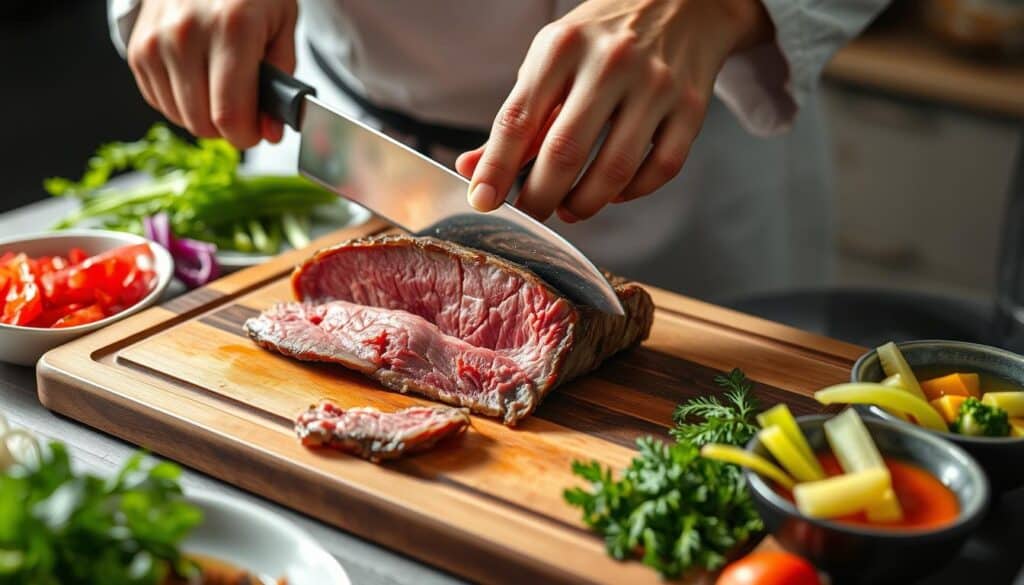
Optimal Marination Time
The marination time depends on the beef cut. Thin slices need 30 minutes to 2 hours. Thicker cuts should marinate for 4-24 hours.
Don’t marinate too long. It can make the meat mushy.
Temperature Considerations
Temperature is key when preparing marinated beef. Take the meat out of the fridge 30 minutes before cooking. This lets it reach room temperature evenly.
When grilling, use high heat. This gives a nice char on the outside while keeping the inside juicy.
| Cut of Beef | Marination Time | Cooking Temperature |
|---|---|---|
| Sirloin | 1-2 hours | High heat (400-450°F) |
| Ribeye | 2-4 hours | Medium-high heat (375-400°F) |
| Flank steak | 4-24 hours | High heat (400-450°F) |
By using these techniques, you’ll make tender, tasty Korean Bulgogi-Style Steak. It will be as good as what you get in restaurants.
Cooking Methods and Equipment
Learning Korean BBQ means knowing how to cook and what tools to use. We’ll look at grilling, indoor cooking, and key tools for tasty grilled beef at home.
Traditional Korean Grilling Techniques
Korean BBQ often uses tabletop grilling. People cook their meat right at the table. This makes dining fun and interactive. A hwaro, a charcoal grill, is used for a smoky taste.
Indoor Cooking Alternatives
Need to cook indoors? No worries! You can make great Korean BBQ at home. A cast-iron grill pan or electric tabletop grill works well. They let you cook like outdoors, but in your kitchen.
Essential Kitchen Tools
To make real Korean BBQ, you need certain tools:
- Grill or grill pan
- Tongs for flipping meat
- Sharp knife for slicing beef
- Marinating container
- Small bowls for side dishes
| Tool | Purpose | Importance |
|---|---|---|
| Grill/Grill Pan | Cooking meat | Essential |
| Tongs | Handling meat | Essential |
| Sharp Knife | Slicing beef | Essential |
| Marinating Container | Preparing meat | Important |
| Small Bowls | Serving side dishes | Helpful |
With these tools and methods, you can make real Korean BBQ at home. Whether grilling outside or inside, you’ll get tasty, tender beef every time.
Step-by-Step Grilling Guide
Grilling Korean Bulgogi-Style Steak is an art that combines tradition with flavor. Our guide will help you master this classic Korean BBQ dish. Let’s dive into the essential steps for perfect grilled beef.
First, preheat your grill to medium-high heat. This ensures a nice sear on the outside while keeping the inside tender. For thin slices of beef, aim for a temperature around 400°F (204°C).
Once your grill is hot, place the marinated meat on the grates. Spread it out evenly to avoid overcrowding. This allows each piece to cook properly and develop that sought-after caramelization.
Grill the beef for about 2-3 minutes per side. The exact time depends on the thickness of your slices and how well-done you prefer your meat. Keep a close eye on it, as Bulgogi cooks quickly due to its thin cut.
- Use tongs to flip the meat, not a fork, to prevent piercing and loss of juices
- Look for a golden-brown color with slightly charred edges
- Remove from heat when the beef is slightly pink in the center for optimal tenderness
For an authentic Korean BBQ experience, serve your grilled Bulgogi-Style Steak immediately. The sizzling meat, paired with traditional sides, creates an unforgettable meal that brings the flavors of Korea to your table.
Traditional Accompaniments and Side Dishes
Korean BBQ is more than grilled meat. It’s a feast with many side dishes. We’ll look at banchan, rice and noodle pairings, and essential sauces.
Classic Korean Banchan Options
Banchan are small side dishes that add flavor and texture. Some popular choices include:
- Kimchi – fermented vegetables, usually cabbage
- Kongnamul – seasoned soybean sprouts
- Japchae – stir-fried glass noodles with vegetables
- Gimbap – Korean-style sushi rolls
Rice and Noodle Pairings
No Korean BBQ is complete without rice or noodles. Steamed white rice is traditional. But we also love these options:
- Bibimbap – mixed rice bowl with vegetables and gochujang sauce
- Naengmyeon – cold buckwheat noodles, perfect for summer
- Jjigae – Korean stew served with a side of rice
Sauce and Condiment Selections
The right sauce can elevate your Korean BBQ. Here are some must-try condiments:
| Sauce | Description | Best Paired With |
|---|---|---|
| Ssamjang | Spicy dipping sauce | Lettuce wraps |
| Gochujang | Red chili paste | Bibimbap, beef tips |
| Doenjang | Fermented soybean paste | Vegetables, soups |
These authentic recipes and pairings will take you to the heart of Asian cuisine. Try different combinations to find your perfect Korean BBQ feast!
Tips for Achieving Restaurant-Quality Results
Making the perfect Korean Bulgogi-Style Steak at home is an art. We’ve gathered expert tips to help you create authentic recipes that rival your favorite Korean restaurant.
Start with high-quality beef. Choose well-marbled ribeye or sirloin for the best flavor and texture. Slice the meat against the grain, about 1/8 inch thick, to ensure tenderness.
For the marinade, balance is key. Mix soy sauce, brown sugar, sesame oil, and Asian pear puree. This combo tenderizes the meat and infuses it with classic Korean flavors. Marinate for at least 2 hours, but no more than 4 to prevent the meat from breaking down too much.
- Use a cast-iron skillet or grill pan for optimal heat distribution
- Cook in small batches to avoid overcrowding the pan
- Aim for a quick sear to lock in juices and create a caramelized exterior
Presentation elevates the dining experience. Serve your Korean Bulgogi-Style Steak on a sizzling hot plate with a side of lettuce leaves for wrapping. Garnish with sesame seeds and green onions for an authentic touch.
“The secret to great Bulgogi is in the details. From meat selection to cooking technique, each step contributes to the final flavor profile.”
Remember, practice makes perfect. Don’t be afraid to experiment with marinades and cooking times to find your ideal Korean Bulgogi-Style Steak recipe. With these tips, you’ll be serving up restaurant-quality meals in no time.
Conclusion
Korean Bulgogi-Style Steak is a true gem of Asian BBQ. We’ve looked into its history, key ingredients, and how to cook it. This dish has been loved for many years, from royal courts to today’s tables.
Learning to make Korean BBQ at home is easy. You just need the right beef, a tasty marinade, and grilling skills. This way, you can make Bulgogi as good as restaurants in your kitchen. The secret is mixing sweet and savory flavors and getting that nice char.
Starting your Bulgogi adventure means more than just cooking. It’s about sharing a meal with loved ones, just like Koreans have for ages. Making this dish is a way to join in on a tradition that has touched many hearts around the world.

